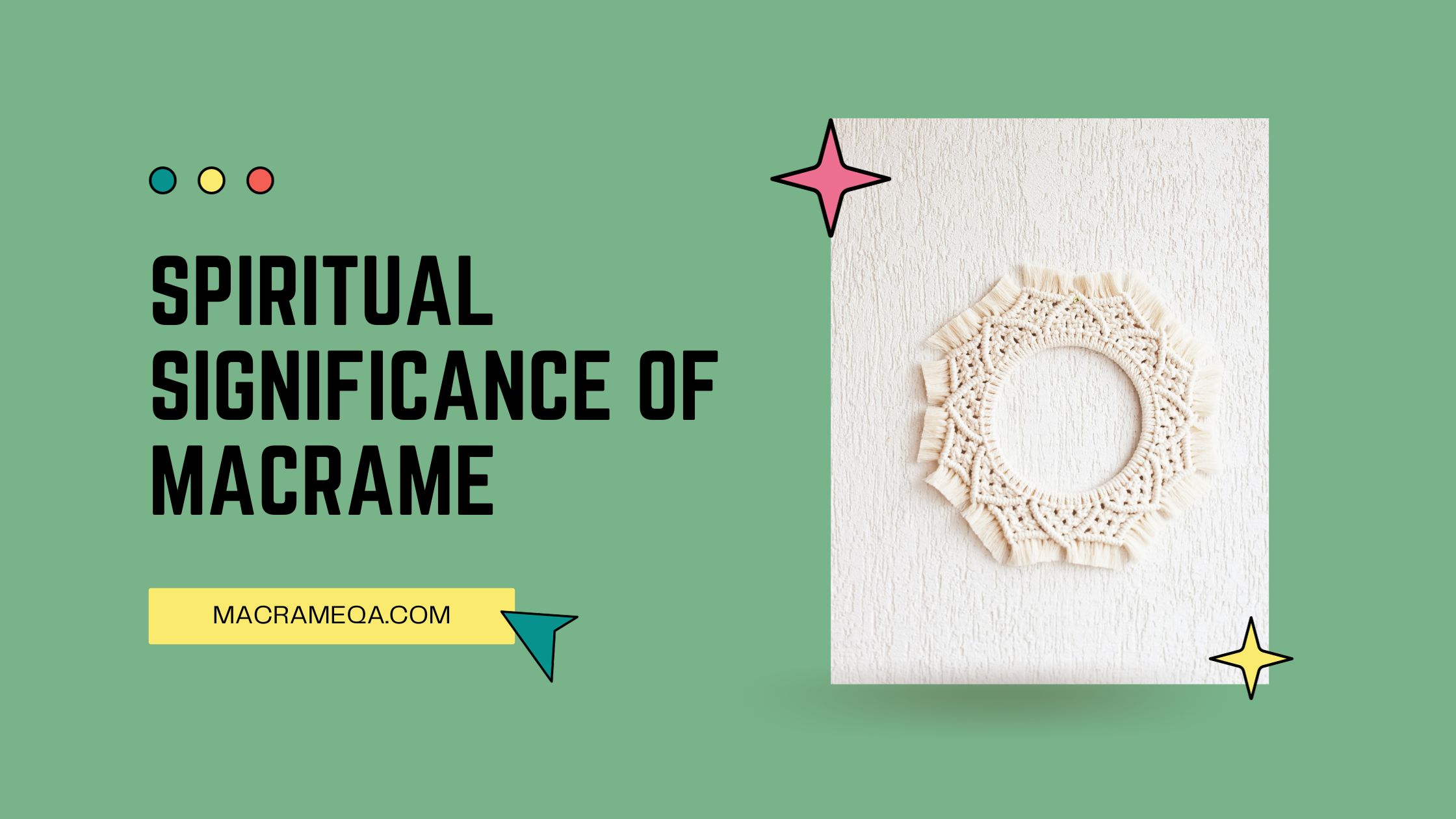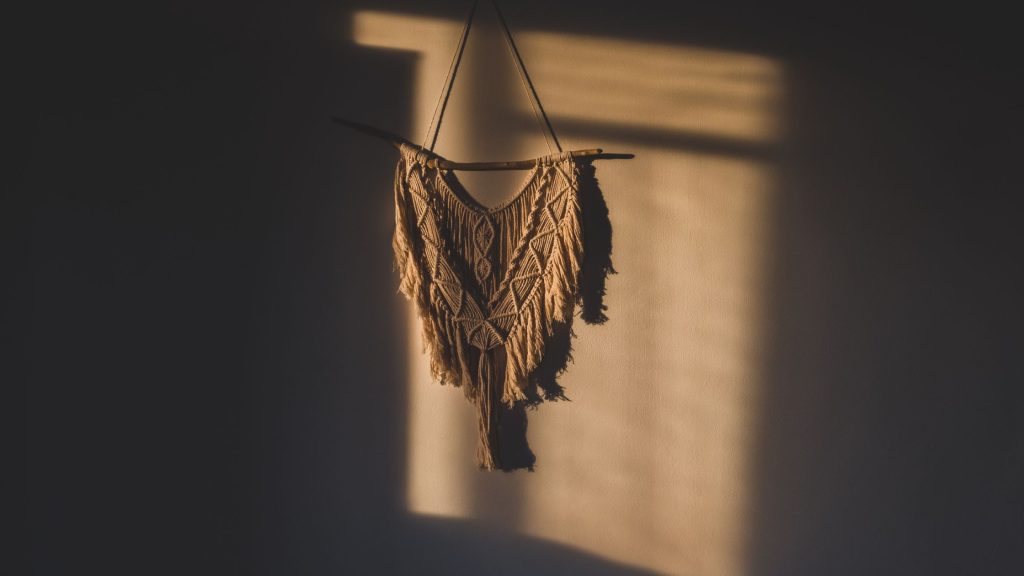Macrame, the art of knotting cords to create intricate patterns, has long been admired for its beauty and craftsmanship. But beyond its aesthetic appeal, many wonder if macrame holds any deeper meaning. Could it have been used as a form of communication or expression of spirituality? In this article, we will explore the history of macrame and investigate whether this ancient craft had any symbolic or spiritual significance.
Macrame: A Brief Introduction
Macrame is an art form that dates back centuries and involves the creation of intricate designs using knotting techniques. It has gained popularity in recent years due to renewed interest in crafts and DIY projects. Macrame is a versatile and creative medium that allows individuals to express their artistic side while also incorporating meaningful elements.
The Origins of Macrame
The exact origins of macrame are unclear, as it has been practiced by various cultures throughout history. Some believe that it originated in ancient Babylon and Assyria, while others attribute its beginnings to Arabic weavers in the 13th century. Macrame gained prominence during the Victorian Era in Europe, where it was used to create decorative items such as curtains, tablecloths, and clothing accessories.
The Art of Knotting
At its core, macrame is the art of knotting. It involves using various types of knots, such as square knots, half-hitch knots, and lark’s head knots, to create intricate patterns and designs. By combining different knotting techniques, artists can create a wide range of textures and shapes, giving macrame its unique appearance.
Popular Uses of Macrame
Macrame has become increasingly popular for both decorative and functional purposes. It is commonly used to create wall hangings, plant hangers, curtains, and jewelry. The versatility of macrame allows individuals to personalize their living spaces and add a touch of bohemian charm to their homes. Additionally, macrame accessories, such as bracelets and necklaces, have become trendy fashion statements.
Symbolism in Macrame
Beyond its aesthetic appeal, macrame also holds symbolic and spiritual significance. The art of knotting carries meaning and can be infused with intention, making macrame more than just a decorative craft.
The Language of Knots
Each knot used in macrame has its symbolism and meaning. For example, the square knot represents balance and harmony, while the overhand knot signifies unity and connection. By combining different knots in their designs, macrame artists can convey specific messages or intentions.
Incorporating Meaningful Elements
Macrame offers the opportunity to incorporate meaningful elements, such as gemstones, crystals, and feathers. These elements can enhance the symbolism of the piece and add a deeper layer of spiritual significance. Gemstones, for instance, are believed to possess specific energies and properties, which can be harnessed through macrame creations.
Historical and Cultural Significance
Throughout history, different cultures have attributed specific meanings and symbolism to macrame. For example, in ancient Egypt, macrame was used to create intricate amulets and talismans believed to protect the wearer from negative energies. In Native American culture, macrame was used to create dream catchers, which were believed to filter out bad dreams and promote peaceful sleep.
Spiritual Connections
Macrame has a deep connection to spirituality and is often incorporated into rituals and ceremonies. Its intricate patterns and symbolic elements make it a powerful tool for spiritual practices.
Macrame in Rituals and Ceremonies
In various spiritual traditions, macrame is used in ritual ceremonies to invoke specific energies or entities. For example, in Wiccan rituals, macrame cords are used to symbolize the connection between the practitioner and the divine. The act of knotting during these ceremonies is believed to bind intentions and enhance the effectiveness of the ritual.
Sacred Spaces and Macrame
Macrame can also be used to create sacred spaces within homes or spiritual environments. By hanging macrame wall hangings or creating macrame dividers, individuals can cultivate a sense of tranquility and establish a dedicated space for meditation, prayer, or spiritual practices. The intricate patterns and textures of macrame add a unique touch to these sacred spaces, enhancing their spiritual ambiance.
Healing and Meditation
The knotting process itself can be therapeutic and meditative. As you engage in the rhythmic and repetitive motion of creating knots, you can enter a state of relaxation and mindfulness. Macrame is often used as a form of therapy to reduce stress, promote focus, and enhance overall well-being.
Macrame and the Elements
The elements of nature play a significant role in macrame, with each element bringing its symbolism and energy into the craft.
Earthly Connections
Macrame, with its use of natural materials such as cotton or jute ropes, has a deep connection to the earth element. The use of earthy tones and textures in macrame designs can evoke a sense of grounding and stability. By incorporating macrame into your living space, you can bring a touch of nature indoors and strengthen your connection to the earth.
Macrame and the Symbolism of Air
Air is another elemental force that can be represented through macrame. The flowing, lightweight nature of macrame designs embodies the essence of air. Hanging macrame pieces near windows or in open spaces can create a sense of movement and breathability, symbolizing the presence of air.
Water and Macrame
Water, with its fluidity and adaptability, can be symbolized through the intricate knots and patterns in macrame. Macrame creations that incorporate flowing or wave-like designs evoke the energy of water, which represents emotions, intuition, and purification. Adding macrame near water features in your home can enhance the connection to the water element and its qualities.
Fire and Macrame
While macrame itself is not associated with fire, the addition of elements such as candles or fiery tones in macrame designs can bring the energy of fire into the space. Fire represents passion, transformation, and creativity. Using macrame to create candle holders or incorporating fiery colors like red or orange into your macrame pieces can invoke the spirit of fire and its symbolic power.
The Influence of Macrame on Belief Systems
Macrame has played a significant role in various belief systems throughout history and continues to be embraced by modern spiritual practices.
Macrame in Ancient Cultures
In ancient cultures, macrame was often used in spiritual and religious ceremonies. For example, in the Inca civilization, macrame was used to create intricate textiles as a form of communication and worship. The art of macrame was highly regarded and seen as a way to honor deities and connect with the spiritual realm.
Macrame’s Role in Modern Spirituality
In modern spirituality, macrame has found renewed popularity as a tool for self-expression, manifestation, and connecting with higher energies. Many individuals incorporate macrame into their daily spiritual practices, such as meditation, energy healing, and visualization. Macrame creations, whether in the form of jewelry or home decor, are seen as reminders and conduits of spiritual energy.
The Power of Intention
One of the key aspects of macrame’s influence on belief systems is the power of intention. Macrame allows individuals to infuse their creations with personal intentions, prayers, or affirmations. By directing focused and positive energy into the creation process, the resulting macrame piece becomes a powerful tool for manifestation and spiritual growth.
Macrame as a Ritual Tool
Macrame can serve as a powerful ritual tool, assisting individuals in their spiritual practices and serving as a conduit for intention.
Talisman and Amulet Macrame
Macrame can be used to create talismans and amulets, which are believed to carry protective energies and provide spiritual support. By using specific knots and incorporating sacred elements, such as crystals or symbols, individuals can create personalized macrame talismans to enhance their connection to their intentions or desired outcomes.
Macrame Prayer Beads
Similar to traditional prayer beads, macrame can be used to create prayer strands that are used as a tool for meditation, concentration, and reflection. These prayer beads can be adorned with gemstones or other spiritual symbols, making them not only visually appealing but also energetically charged.
Creating Sacred Objects
Macrame can be used to create various sacred objects that hold spiritual significance. For example, dream catchers made from macrame represent protection and the filtering of negative energies. Mandala-inspired macrame wall hangings can serve as focal points for meditation and introspection. The possibilities are endless, and individuals can create customized macrame pieces that align with their unique spiritual practices and beliefs.
Colors and Their Symbolism in Macrame
Colors play a vital role in macrame, as they hold their symbolism and can enhance the message or intention behind a piece.
The Psychology of Color
Colors have long been associated with emotions and have the power to evoke specific feelings or energies. In macrame, color selection is crucial in conveying the desired symbolism or mood. For example, using calming blues and greens can create a sense of tranquility, while vibrant reds and oranges can stimulate passion and creativity.
Chakra Colors in Macrame
Chakra colors, which correspond to the energy centers within the body, can also be incorporated into macrame designs. Each chakra is associated with a specific color, and by using these colors, individuals can stimulate and balance the corresponding energy centers.
Color Symbolism in Different Cultures
Different cultures attribute their meanings to colors, and this can be reflected in macrame designs. For instance, in Chinese culture, red symbolizes luck and good fortune, while in Native American culture, turquoise represents protection and communication. By incorporating these culturally significant colors into macrame, individuals can honor and connect with specific cultural traditions.
The Sacred Geometry of Macrame
Sacred geometry, a mathematical and philosophical concept, can be seen in the intricate patterns and designs of macrame.
Fibonacci Sequence and Macrame Patterns
The Fibonacci sequence, a mathematical pattern found in nature, can be observed in various macrame patterns. These patterns, characterized by a sequence of numbers where each number is the sum of the two preceding numbers, create visually appealing and harmonious designs. The incorporation of the Fibonacci sequence in macrame reflects the interconnectedness of all things and aligns with the principles of sacred geometry.
Sacred Geometry in Macrame Designs
Macrame designs often showcase various geometric shapes, such as triangles, squares, and circles. These shapes hold symbolic significance in sacred geometry. For example, triangles represent manifestation and spiritual evolution, while circles represent unity and wholeness. By incorporating these shapes into macrame designs, individuals can infuse their creations with the inherent wisdom and energy of sacred geometry.
Macrame and the Spirit of Nature
Nature serves as a significant inspiration for macrame designs, and incorporating natural materials and elements into macrame pieces enhances their connection to the spirit of nature.
Integrating Natural Materials
Macrame is often created using natural materials such as cotton, hemp, or jute ropes, which not only adds an earthy aesthetic but also aligns with the principles of sustainability and eco-consciousness. By choosing natural materials, individuals can enhance the natural energy and connection to the earth in their macrame creations.
Macrame and the Energy of Plants
A popular use of macrame is creating plant hangers, allowing individuals to showcase their favorite indoor plants decoratively and practically. Macrame plant hangers not only add a touch of bohemian style to any space but also create a harmonious connection between the plant and its surroundings. The combination of macrame and plants brings the energy of nature indoors, fostering a sense of vitality and growth.
Nature-Inspired Macrame Designs
Macrame designs often incorporate patterns and shapes inspired by the natural world, such as leaves, waves, or feathers. These nature-inspired designs embody the beauty and harmony found in nature and serve as reminders of the interconnectedness between humans and the natural world. By incorporating these elements into macrame, individuals can bring the spirit of nature into their living spaces.
Conclusion
Macrame is more than just an art form; it carries deep symbolic and spiritual significance. From its origins in ancient cultures to its role in modern spirituality, macrame has been used to convey messages, enhance rituals, and create sacred objects. By incorporating meaningful elements, colors, and intention into their designs, individuals can tap into the spiritual energy of macrame and experience the transformative power it holds. Whether used as a decorative piece or for spiritual practices, macrame offers a beautiful and meaningful way to appreciate the artistry and symbolism it embodies.

















